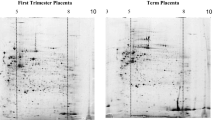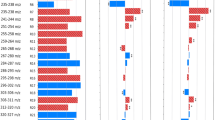Abstract
The human placenta plays an important role in foetus development and growth and is also well known as the reservoir of the mesenchymal stem cells (MSCs), which are characterized by significantly higher plasticity in comparison to adult stem cells as well as by the ability to differentiate into multiple cell types. Therefore, they are promising candidates for stem-cell therapy. To understand that mechanism the description of their proteomic profile is required. In this context, the goal of the present study was to isolate and analyse the proteome from chorionic membrane of the human placenta. The whole-cell protein extracts were analysed by LC MS/MS utilizing bottom-up proteomic approach. To maximize the number of identified proteins, two different nanoLC approaches were used. In the first approach only one-dimensional pre-concentration setup (C18 reverse-phase column) was used; whereas, the second approach utilized the two-dimensional LC in a salt plug setup (first dimension—SCX column and second dimension—C18 reverse-phase column). The method validation was accomplished using foetal membranes of six donors. Identification of 334, respectively, 500 proteins as part of chorionic MSCs proteome is reported here, supported by gene ontology classification and systematic protein family ordering. Complete characterization of chorionic stem-cell proteome profile will contribute to identification and understanding of the molecular pathways involved in the cell processes such as self-renewal, proliferation and differentiation.



Similar content being viewed by others
References
Barry FP, Murphy JM (2004) Mesenchymal stem cells: clinical application and biological characterization. Int J Biochem Cell Biol 36:568–584
Minguell JJ, Erices A, Conget P (2001) Mesenchymal stem cells. Exp Biol Med 226:507–520
Tocci A, Forte L (2003) Mesenchymal stem cell: use and perspectives. Hematol J 4:92–96
Miao Z, Jin J, Chen L, Zhu J, Huang W, Zhao J, Qian H, Zhang X (2006) Isolation of mesenchymal stem cell from human placenta: comparison with human bone marrow mesenchymal stem cells. Cell Biol Int 30:681–687
Kurt B, Peter K (2000) Pathology of the human placenta, 4th edn. Springer, New York
Pasquinelli G, Tazzari P, Ricci F, Vaselli C, Buzzi M, Conte R, Orrico C, Foroni L, Stella A, Alviano F, Bagnara GP, Lucarelli E (2007) Ultrastructural characteristics of human mesenchymal stromal (stem) cells derived from bone marrow and term placenta. Ultrastruct Pathol 31:23–31
Weissmanm IL, Anderson DJ, Gage F (2001) Stem and progenitor cells: origins, phenotypes, lineage commitments, and transdifferentiations. Annu Rev Cell Dev Biol 17:387–403
Smith AG (2001) Embryo-derived stem cells: of mice and men. Annu Rev Cell Dev Biol 17:435–462
Soncini M, Vertua E, Gibelli L, Zorzi F, Denegri M, Albertini A, Wengler GS, Parolini O (2007) Isolation and characterization of mesenchymal cells from human fetal membranes. J Tissue Eng Regen Med 1:296–305
In ‘t Anker PS, Scherjon SA, Kleijburg-van der Keur C, de Groot-Swings GM, Claas FH, Fibbe WE, Kanhai HH (2004) Isolation of mesenchymal stem cells of fetal or maternal origin from human placenta. Stem Cells 22:1338–1345
Portmann-Lanz CB, Schoeberlein A, Huber A, Sager R, Malek A, Holzgreve W, Surbek DV (2006) Placental mesenchymal stem cells as potential autologous graft for pre- and perinatal neuroregeneration. Am J Obstet Gynecol 194:664–673
Zhang X, Mitsuru A, Igura K, Takahashi K, Ichinose S, Yamaguchi S, Takahashi TA (2006) Mesenchymal progenitor cells derived from chorionic villi of human placenta for cartilage tissue engineering. Biochem Biophys Res Commun 340:944–952
Gilar M, Olivova P, Daly AM, Gebler JC (2005) Two-dimensional separation of peptides using RP-RP-HPLC system with different pH in first and second separation dimensions. J Sep Sci 28:1694–1703
Hochleitner EO, Bakry R, Huck CW, Flores F, Stögl WM, Stecher G, Bonn GK (2003) Analysis of isolectins on non-porous particles and monolithic polystyrene-divinylbenzene based stationary phases and electrospray ionization mass spectrometry. Int J Mass Spectrom 223–224:519–526
Mi H, Huang X, Muruganujan A, Tang H, Mills C, Kang D, Thomas PD (2016) PANTHER version 11: expanded annotation data from gene ontology and reactome pathways, and data analysis tool enhancements. Nucleic Acids Res. doi:10.1093/nar/gkw1138
Mi H, Muruganujan A, Casagrande JT, Thomas PD (2013) Large-scale gene function analysis with the PANTHER classification system. Nat Protoc 8:1551–1566. doi:10.1038/nprot.2013.092
Barkholt V, Jensen AL (1989) Amino acid analysis: determination of cysteine plus half-cystine in proteins after hydrochloric acid hydrolysis with a disulfide compound as additive. Anal Biochem 177:318–322
Wang HS, Hung SC, Peng ST, Huang CC, Wei HM, Guo YJ, Fu YS, Lai MC, Chen CC (2004) Mesenchymal stem cells in the Wharton’s jelly of the human umbilical cord. Stem Cells 22:330–1337
De Coppi P, Bartsch G Jr, Siddiqui MM, Xu T, Santos CC, Perin L, Mostoslavsky G, Serre AC, Snyder EY, Yoo JJ, Furth ME, Soker S, Atala A (2007) Isolation of amniotic stem cell lines with potential for therapy. Nat Biotechnol 25:100–106
Roubelakis MG, Pappa KI, Bitsika V, Zagoura D, Vlahou A, Papadaki HA, Antsaklis A, Anagnou NP (2007) Molecular and proteomic characterization of human mesenchymal stem cells derived from amniotic fluid: comparison to bone marrow mesenchymal stem cells. Stem Cells Dev 16:931–951
Fukuchi Y, Nakajima H, Sugiyama D, Hirose I, Kitamura T, Tsuji K (2004) Human placenta-derived cells have mesenchymal stem/progenitor cell potential. Stem Cells 22:649–658
Case D, Irwin D, Ivester C, Harral J, Morris K, Imamura M, Roedersheimer M, Patterson A, Carr M, Hagen M, Saavedra M, Crossno J Jr, Young KA, Dempsey EC, Poirier F, West J, Majka S (2007) Mice deficient in galectin-1 exhibit attenuated physiological responses to chronic hypoxia-induced pulmonary hypertension. Am J Physiol Lung Cell Mol Physiol 292:L154–L164
Blois SM, Ilarregui JM, Tometten M, Garcia M, Orsal AS, Cordo-Russo R, Toscano MA, Bianco GA, Kobelt P, Handjiski B, Tirado I, Markert UR, Klapp BF, Poirier F, Szekeres-Bartho J, Rabinovich GA, Arck PC (2007) A pivotal role for galectin-1 in fetomaternal tolerance. Nat Med 13:1450–1457
Feldmann RE Jr, Bieback K, Maurer MH, Kalenka A, Bürgers HF, Gross B, Hunzinger C, Klüter H, Kuschinsky W, Eichler H (2005) Stem cell proteomes: a profile of human mesenchymal stem cells derived from umbilical cord blood. Electrophoresis 26:2749–2758
Vogt JA, Schroer K, Hölzer K, Hunzinger C, Klemm M, Biefang-Arndt K, Schillo S, Cahill MA, Schrattenholz A, Matthies H, Stegmann W (2003) Protein abundance quantification in embryonic stem cells using incomplete metabolic labelling with 15N amino acids, matrix-assisted laser desorption/ionisation time-of-flight mass spectrometry, and analysis of relative isotopologue abundances of peptides. Rapid Commun Mass Spectrom 17:1273–1282
Sun HJ, Bahk YY, Choi YR, Shim JH, Han SH, Lee JW (2006) A proteomic analysis during serial subculture and osteogenic differentiation of human mesenchymal stem cell. J Orthop Res 24:2059–2071
Das KC (2004) Thioredoxin system in premature and newborn biology. Antioxid Redox Signal 6:177–184
Kropotov A, Gogvadze V, Shupliakov O, Tomilin N, Serikov VB, Tomilin NV, Zhivotovsky B (2006) Peroxiredoxin V is essential for protection against apoptosis in human lung carcinoma cells. Exp Cell Res 312:2806–2815
Engler AJ, Sen S, Sweeney HL, Discher DE (2006) Matrix elasticity directs stem cell lineage specification. Cell 126:677–689
Acknowledgements
This study was supported by the Agency of the Ministry of Education, Science, Research and Sport of the Slovak Republic for the Structural Funds of EU under Projects ITMS: 26220220163 and ITMS: 26220120067.
Author information
Authors and Affiliations
Corresponding authors
Ethics declarations
Conflict of interest
Authors declare no conflict of interest.
Rights and permissions
About this article
Cite this article
Chmelova, M., Geci, I., Talian, I. et al. Proteomic Analysis of Chorion-Derived Mesenchymal Stem Cells: Combination of 2D Nano-HPLC in Tandem with ESI Mass Spectrometry. Chromatographia 80, 201–207 (2017). https://doi.org/10.1007/s10337-017-3246-x
Received:
Revised:
Accepted:
Published:
Issue Date:
DOI: https://doi.org/10.1007/s10337-017-3246-x




